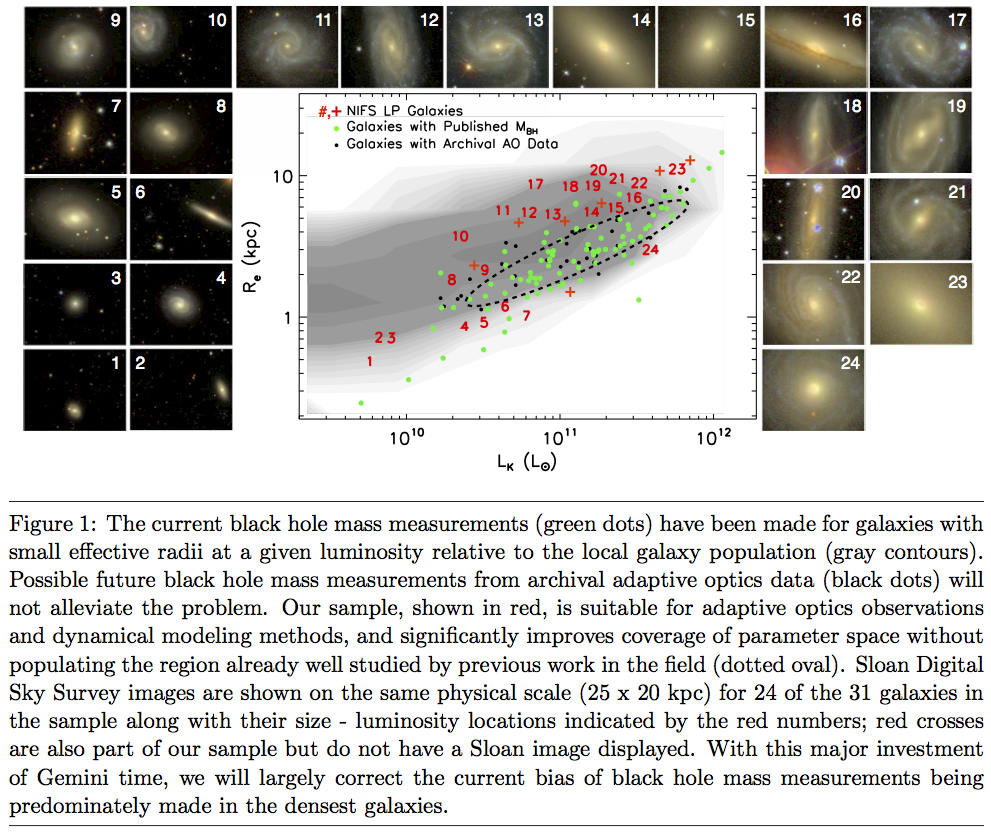Principal Investigator: Jonelle Walsh, Texas A&M University
Program Summary:
Supermassive black holes are essential components of galaxies - they regulate galaxy properties and impact star formation via feedback processes, dynamically influence the shape of galaxies, and give rise to exotic phenomena such as the ejection of high-velocity stars. About 90 black hole mass measurements in nearby galaxies have been built up over the past two decades, leading to the establishment of tight correlations between the mass of a central black hole and its host galaxy’s large-scale properties. Our understanding of the underlying physics driving the empirical relations, however, is limited by the present sample of galaxies. In particular, dynamical black hole mass determinations have been preferentially made in galaxies with small sizes at a given luminosity relative to the local galaxy population.
Our program addresses this troublesome bias using Gemini NIFS behind laser guide star adaptive optics to detect and weigh black holes in 31 nearby galaxies. By specifically targeting those galaxies with sizes and luminosities that are currently not well represented in the existing sample of black hole mass measurements, we will obtain a more complete census of local black holes in a wide range of galaxies with diverse evolutionary histories. Forgoing the approach that we have used for years of measuring a few black holes at a time, and instead examining large, homogenous datasets of carefully selected samples is the ideal way to achieve a breakthrough in our understanding the co-evolution of black holes and galaxies before the next generation of large telescopes come online.

Co-Investigators:
- Remco van den Bosch, Max-Planck-Institut fur Astronomie
- Aaron Barth, University of California, Irvine
- Holger Baumgardt, University of Queensland
- John Blakeslee, Herzberg Institute of Astrophysics
- Carlos Donzelli, Observatorio Astronomico
- Laura Ferrarese, Herzberg Institute of Astrophysics
- Karl Gebhardt, University of Texas at Austin
- Jenny Greene, Princeton University
- Kayhan Gultekin, University of Michigan
- Inger Jorgensen, Gemini Observatory
- Markus Kissler-Patig, Gemini Observatory
- Davor Krajnovic, Leibniz-Institut fur Astrophysik Potsdam
- Ronald Lasker, University of Turku
- Tod Lauer, National Optical Astronomy Observatory
- Nora Lutzgendorf, Space Telescope Science Institute
- Mariya Lyubenova, University of Groningen
- Chung-Pei Ma, University of California, Berkeley
- Nicholas McConnell, Herzberg Institute of Astrophysics
- Richard McDermid, Macquarie University
- Bryan Miller, Gemini Observatory
- Roderik Overzier, Observatorio Nacional
- Anil Seth, University of Utah
- Thaisa Storchi-Bergmann, Universidade Federal do Rio Grande do Sul
- Monica Valluri, University of Michigan
- Glenn van de Ven, Max-Planck-Institut fur Astronomie
- Jakob Walcher, Leibniz-Institut fur Astrophysik Potsdam
- Akin Yildirim, Max-Planck-Institut fur Astronomie